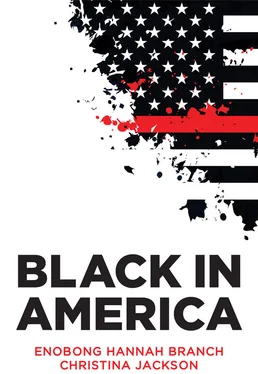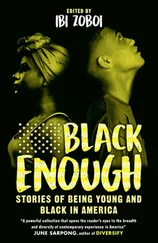1 Cover
2 Front Matter Black in America The Paradox of the Color Line Enobong Hannah Branch Christina Jackson polity
3 About the Contributors About the Contributors Authors Enobong Hannah Branch is a professor of Sociology and Vice Chancellor for Diversity, Inclusion, and Community Engagement, at Rutgers University–New Brunswick. Her research interests are in race, racism, and inequality; intersectional theory; work and occupations; and diversity in science. She is the author of Opportunity Denied: Limiting Black Women to Devalued Work (2011), and the editor of Pathways, Potholes, and the Persistence of Women in Science: Reconsidering the Pipeline (2016), as well as several journal articles and book chapters that explore the historical roots and contemporary underpinnings of inequality. Christina Jackson is an assistant professor of Sociology at Stockton University in New Jersey. Her research interests are primarily in the intersections of race, class, and gender; social inequality; urban spaces; social movements; and the politics of redevelopment and gentrification. She is the co-author of Embodied Difference: Divergent Bodies in Public Discourse with Jamie A. Thomas (2019), as well as several journal articles and book chapters.
4 Introduction: Are We “Post-Racial” Yet? Black in America: Revisiting Martin Luther King Jr.’s Dream Book Features Notes
5 1 How Blacks Became the Problem: American Racism and the Fight for Equality Defining the Problem: Critical and Conventional Approaches to Race and Racism Racism in an Institution: Education, Jim Crow and the Racial State A Critical Race Approach to Blacks in America Conclusion: American Racism and the Black Community Critical Reflection Questions Notes
6 2 Crafting the Racial Frame: Blackness and the Myth of the Monolith Controlling Images and the Caricature of the Black Family in Popular Media Defined from Without: The Black Immigrant Experience Complicating the Racial Frame: Confidence in Blackness Blackness and its Intersections Conclusion: The Black Community Pulling Apart Critical Reflection Questions Notes
7 3 Whose Life Matters? Value and Disdain in American Society “First, Do No Harm”: Eugenics, Medicine and Devaluing Black Life Understanding Black Resistance Resistance at the Ballot Box: Pursuing the Party of Equality The Black Freedom Movement and the Civil Rights Movement Racializing Religion, Piety and Resistance The Rise of Black Radicalism The Era of Black Lives Matter Conclusion: The Media and the Future of Black Resistance Critical Reflection Questions Notes
8 4 Staying Inside the Red Line: Housing Segregation and the Rise of the Ghetto Urban Black Settlement Patterns and the Negro Problem Urban Segregation and the Creation of the Ghetto Urban Renewal as Black Removal and Displacement Racial Attitudes and Gentrification Conclusion: Toward a Revitalization of the Ghetto Critical Reflection Questions
9 5 Who Gets to Work? Understanding the Black Labor Market Experience Labor and Race-Making in a Historical Perspective War and Black Labor Equal Opportunity Under the Law, Almost a New Day for Black Labor Working Poverty, Welfare and the Racial Frame Conclusion: Race and Class, Exploring the Prism of Difference Critical Reflection Questions Notes
10 6 Is Justice Blind? Race and the Rise of Mass Incarceration Policing the Black Body: Race, Surveillance and Mass Criminalization Connecting the Past and Present: The Sociohistoric Roots of the “Black Crime Problem” Black Criminality and Racial Threat “Tough on Crime” Problem Produced: Caste, Citizenship and other Carceral Creations Normalizing Surveillance: Racial Formation and the Forces Driving Mass Incarceration Conclusion: Becoming Criminal, the Role of the School-to-Prison Pipeline Critical Reflection Questions Notes
11 7 Reifying the Problem: Racism and the Persistence of the Color Line in American Politics The “Southern Strategy,” the Grand Realignment and the Backlash Against Civil Rights Racial Appeals and Presidential Politics Obama and the Mirage of Post-racial Politics Racial Politics and Race(d) Policy Conclusion: Black Protest, the Politics of Representation, and Resistance Critical Reflection Questions Notes
12 Epilogue
13 Glossary
14 References
15 Index
16 End User License Agreement
1 Chapter 1 Case Study 1Blacks as the Undesirable Population in San Francisco
2 Chapter 2 Case Study 2Black Lives Matter Group Grapples with Sexuality
3 Chapter 3 Case Study 3Defining Black Lives Matter Locally in Atlantic City
4 Chapter 4 Case Study 4Memories of Living within the Red Line
5 Chapter 5 Case Study 5Black Women’s Labor Withdrawal after Emancipation
6 Chapter 6 Case Study 6Black Men Making Good: Re-entry in the Fillmore Neighborhood
7 Chapter 7 Case Study 7Mobilizing and Forcing Justice: Political Accountability in San Francisco
1 Cover
2 Table of Contents
3 Begin Reading
1 iii
2 iv
3 v
4 ix
5 x
6 1
7 2
8 3
9 4
10 5
11 6
12 7
13 8
14 9
15 10
16 11
17 12
18 13
19 14
20 15
21 16
22 17
23 18
24 19
25 20
26 21
27 22
28 23
29 24
30 25
31 26
32 27
33 28
34 29
35 30
36 31
37 32
38 33
39 34
40 35
41 36
42 37
43 38
44 39
45 40
46 41
47 42
48 43
49 44
50 45
51 46
52 47
53 48
54 49
55 50
56 51
57 52
58 53
59 54
60 55
61 56
62 57
63 58
64 59
65 60
66 61
67 62
68 63
69 64
70 65
71 66
72 67
73 68
74 69
75 70
76 71
77 72
78 73
79 74
80 75
81 76
82 77
83 78
84 79
85 80
86 81
87 82
88 83
89 84
90 85
91 86
92 87
93 88
94 89
95 90
96 91
97 92
98 93
99 94
100 95
101 96
102 97
103 98
104 99
105 100
106 101
107 102
108 103
109 104
110 105
111 106
112 107
113 108
114 109
115 110
116 111
117 112
118 113
119 114
120 115
121 116
122 117
123 118
124 119
125 120
126 121
127 122
128 123
129 124
130 125
131 126
132 127
133 128
134 129
135 130
136 131
137 132
138 133
139 134
140 135
141 136
142 137
143 138
144 139
145 140
146 141
147 142
148 143
149 144
150 145
151 146
152 147
153 148
154 149
155 150
156 151
157 152
158 153
159 154
160 155
161 156
162 157
163 158
164 159
165 160
166 161
167 162
168 163
169 164
170 165
171 166
172 167
173 168
174 169
175 170
176 171
177 172
178 173
179 174
180 175
181 176
182 181
183 182
184 183
185 184
186 185
187 186
188 187
189 188
190 189
191 190
192 191
193 192
194 193
195 194
196 195
197 196
198 197
199 198
200 199
Читать дальше












